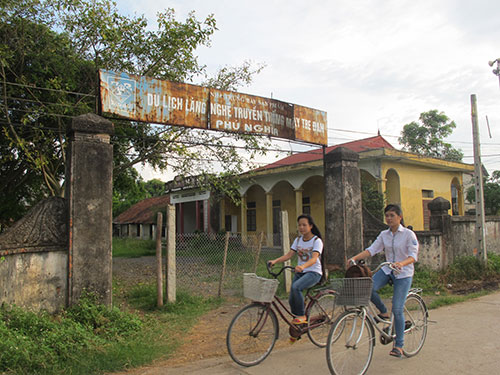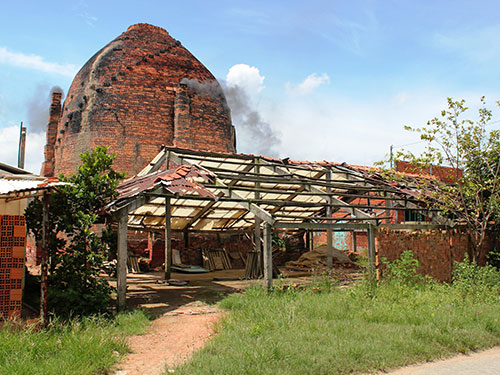Explaining the death of craft villages
The craft villages fall into distress because of their own faults. Some villages do business without a long-term development plan. Some others label their products as Chinese goods.

The product showcase area of Phu Vinh village, in Phu Nghia commune, Chuong My district, Hanoi is deserted.
Located along National Highway 1, the traditional house of Phuoc Kieu bronze casting village in DienPhuong Commune, Dien Ban District, Quang Nam Province, is closed all the time.
Meanwhile, households in the village do not have enough orders to operate regularly. Mr. Tran Dinh Tri, a villager, said: "In this village, every man for himself."
Defeated by Chinese goods
According to a senior artisan of Phuoc Kieu village, the traditional job of Phuoc Kieu is affected because a number of private workshops do business honestly.
Many stores are named after the famous brand of Phuoc Kieu but they sell bronze items purchased from the provinces of Thua Thien - Hue, Bac Giang or Ho Chi Minh City. They also play a dirty trick on others.
Unhealthy competition is also popular in a few craft villages in Hanoi, such as Van Phuc silk village (Ha Dong district) and Bat Trang pottery village (Gia Lam district).
Mr. Luu Duy Dan, chairman of the Association of Vietnam Craft Villages, said in Bat Trang, a number of households import Chinese ceramics and label them with Bat Trang brand for sale. Some people play tricks to gain advantage in competition.
In Van Phuc, some people purchase silks from elsewhere to turn them into Van Phuc silk. Many craft villages are dying because of lacking long-run development strategies and losing their prestige.
On the other hand, the product range of craft villages are too monotonous and sometimes low quality so they are not selected by foreign partners and foreign tourists.
Explaining this issue, Mr. Nguyen Ky from Ma Chau weaving village in Duy Xuyen District, Quang Nam Province, said that textile products from craft villages are less favored in the market because they cannot compete with Chinese goods which have nice design and cheap.
One more reason mentioned by artisans is that they have to buy materials at high price and have to pay immediately while they are not paid immediately for their products. As a result, they lack of capital for reinvestment.
Backward technology causes pollution

Brick and ceramic kilns in My Phuoc Commune, Mang Thit District, Vinh Long Province exhaust fumes causing environment pollution.
While many craft villages in Hanoi, Thua Thien – Hue and Quang Nam are operating in moderation, the tile and ceramic villages in the two provinces of Vinh Long and An Giang are forced to narrow production scale because their outdated methods of production causes environmental pollution.
According to the Department of Natural Resources and Environment of Vinh Long province, brick kilns in the province released high concentrations of hydrofluoric acid. In some places, it is 10-30 times exceeding the limits, affecting the health of local people. Most of these facilities do not cover rice husks and ash so when there is strong wind, it is blown to rivers, canals and houses.
Mr. Truong Chi Thien – Deputy Director of the Industry and Trade Division of Mang Thit District, Vinh Long Province - said because traditional brick kilns cause pollution, the local authorities have banned them from expansion, unless they change their technology.
Mr. Tran Minh Doan, from the Cho Thu carpentry village in Cho Moi district, An Giang province, said sawdust and PU paint from carpentry workshops cause heavy pollution.
For sustainable development of the village, locals need state assistance to purchase modern machinery and equipment, to set up a concentrated production area which is far from residential areas and to open showrooms.
Doan also suggested building factories to process sawdust into charcoal to use in cooking, which can help increase profits and lessen environmental pollution.
Capital needed
Ms. Le Thi Hanh, from the Department of Trade and Industry of Thua Thien - Hue province, said the agency is trying to turn 1-2 enterprises in each craft village into the big ones and will seek investment for these villages to deal with the above issues.
Also facing financial difficulty, Ms. Nguyen Thi Han, the owner of a rattan and bamboo manufacturing facility for exports in Phu Vinh village, Hanoi, lamented: "It is so hard to have access to bank loans at present. Sometimes when you got the loan, it is too late because customers cannot wait."
According to Mr. Luu Duy Dan, chairman of the Association of Vietnam Craft Villages, up to 80 percent of households and production facilities in craft villages are inaccessible to bank loans because of strict regulations.
Source: NLD
Không có nhận xét nào:
Đăng nhận xét